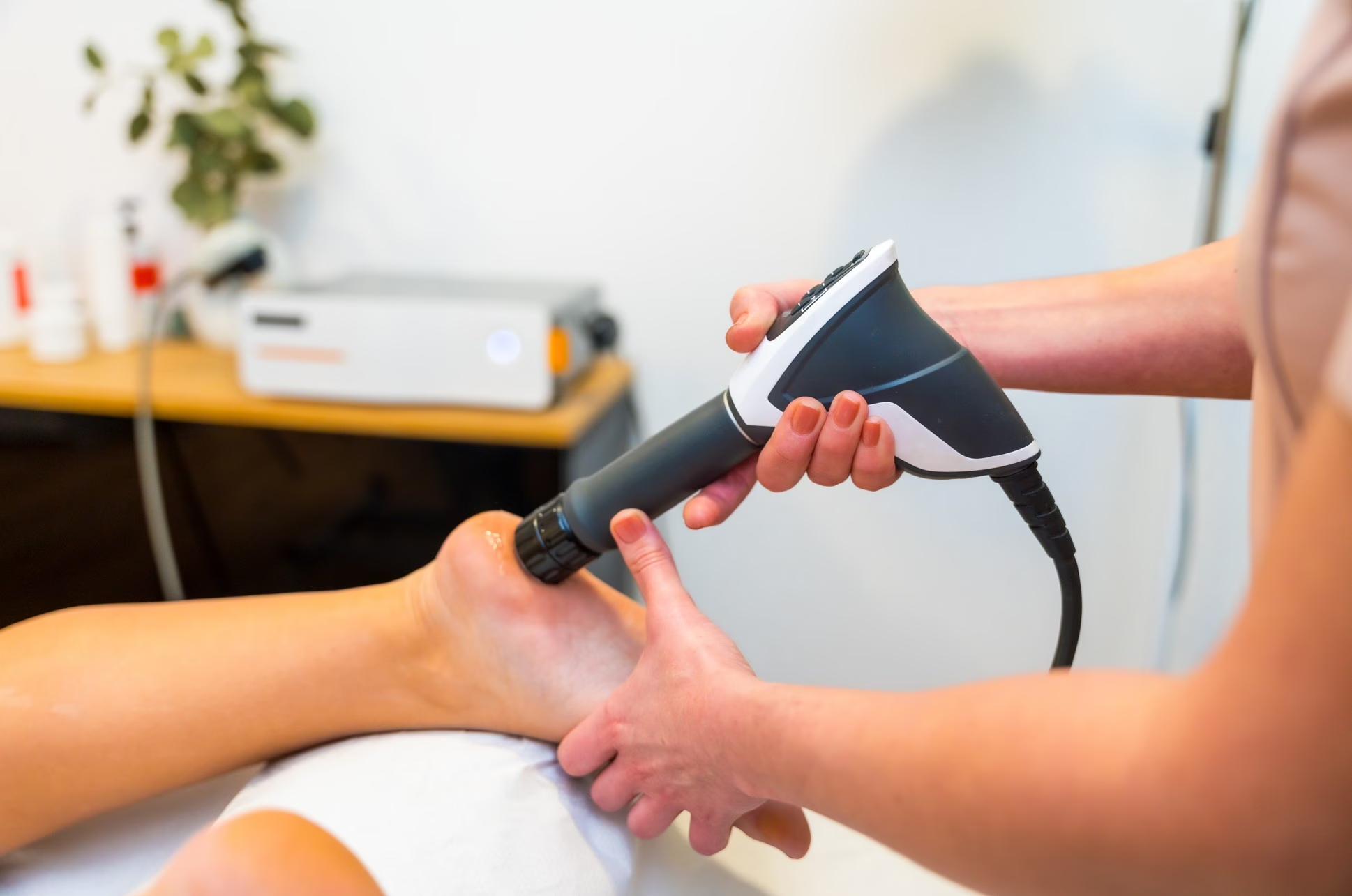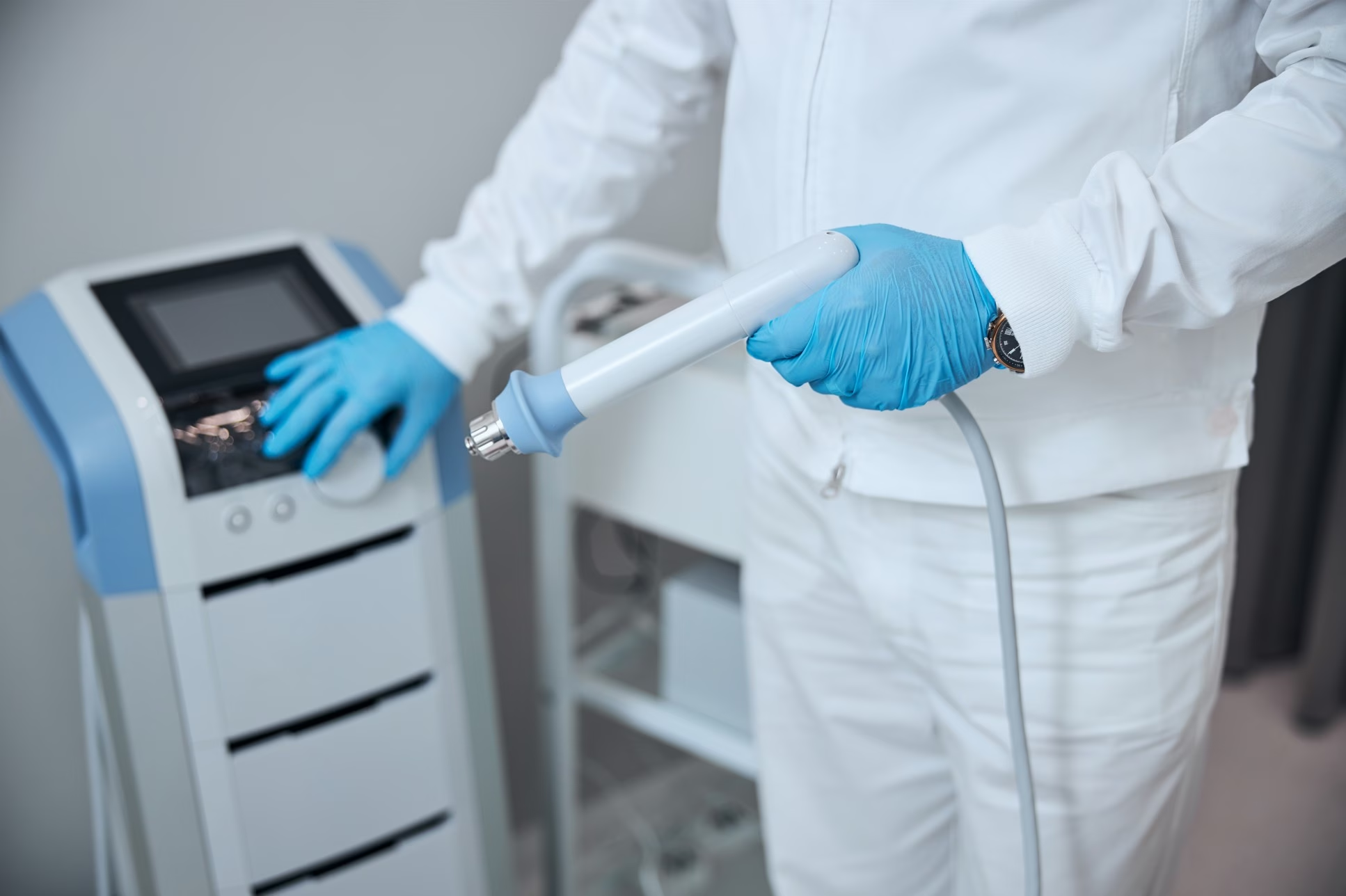Shockwave Therapy

Does Shockwave Therapy Really Work?
If you’ve been living with tendon pain that just won’t go away, you’re probably feeling frustrated. Maybe you’ve tried rest, exercises or even injections, but nothing has given lasting relief.
Research suggests that shockwave therapy—a non-invasive treatment using focused sound waves—can help stubborn conditions like plantar fasciitis, Achilles tendinopathy and tennis elbow.
While it’s not a miracle cure, studies show that it can speed up healing when combined with a structured exercise programme. At Southampton Physio, we use shockwave therapy as part of a broader plan to get you moving confidently again.
What is Shockwave Therapy?
Shockwave therapy (also known as extracorporeal shockwave therapy, or ESWT) uses high-energy sound waves to stimulate healing in injured tissues.
During treatment, a device delivers pulses of acoustic energy through the skin. This energy increases blood flow, reduces pain signalling and encourages your body to repair itself.
Most people describe the sensation as a series of strong taps or pulses on the skin. It can feel a little uncomfortable, especially over very sensitive areas, but it’s generally well tolerated.
Evidence suggests that shockwave therapy can help:
- Reduce chronic tendon pain
- Break down calcific deposits in tissues
- Improve circulation and tissue regeneration
It’s particularly useful when symptoms have persisted for several months despite rest and rehabilitation.


What Conditions Can It Help?
Shockwave therapy is most commonly used for chronic tendon problems, including:
- Plantar fasciitis: Ongoing heel pain caused by thickening of the plantar fascia under the foot.
- Achilles tendinopathy: Pain and stiffness in the tendon at the back of your ankle.
- Tennis elbow: Pain around the outside of your elbow from overuse or strain.
- Calcific shoulder tendinopathy: Calcium deposits causing pain and reduced movement.
If you’ve tried other treatments without success, shockwave therapy can be an alternative to injections or surgery.
However, it’s not suitable for everyone. We’ll always assess your condition thoroughly to check whether it’s likely to help you.
What Happens During Treatment?
When you come in for shockwave therapy at Southampton Physio, your session usually lasts around 20–30 minutes.
Here’s what to expect:
Assessment:
Your clinician will confirm your diagnosis, check for any contraindications and explain the process.
Preparation:
A gel is applied to the skin to help transmit the sound waves.
Treatment:
The shockwave device is placed on the affected area. You’ll feel rapid pulses or taps. Most people find it tolerable, and we can adjust the intensity if needed.
Aftercare:
You may have some soreness or redness for a day or two. This is normal and often settles quickly.
Most treatment plans involve three to six sessions, spaced about a week apart.
Evidence suggests combining shockwave therapy with a tailored rehabilitation programme provides the best outcomes. After your session, we’ll guide you through progressive exercises to strengthen and load the tendon safely.


Who is Shockwave Therapy Suitable For?
Shockwave therapy can be effective for people with persistent tendon pain that hasn’t responded to other treatments.
It’s often used when symptoms have been present for at least three to six months.
However, it’s not suitable for everyone. You may not be a candidate if you:
- Have a blood clotting disorder or are taking certain anticoagulant medications
- Are pregnant
- Have an active infection or tumour in the treatment area
- Have severe nerve or circulation problems
Before starting, we’ll always discuss your medical history and assess whether shockwave therapy is appropriate.
If you’re unsure, we encourage you to book an assessment so we can talk through your options and decide together.
Frequently Asked Questions (FAQs)
How effective is shockwave therapy?
Evidence suggests shockwave therapy can reduce pain and improve function in conditions like plantar fasciitis, Achilles tendinopathy and tennis elbow. Most people notice improvement after a few sessions, but results can vary. It works best when combined with an exercise programme.
How many sessions will I need?
Typically, you’ll have three to six sessions, spaced about a week apart. Your clinician will tailor the plan to your condition and response to treatment.
Is shockwave therapy painful?
You might feel discomfort or a strong tapping sensation during treatment, especially over sensitive areas. Most people find it tolerable, and we can adjust the intensity if needed.
What are the side effects?
Mild redness, swelling or bruising in the treated area can happen and usually settle within a few days. Serious side effects are rare.
How much does it cost?
We’ll explain all costs clearly at your assessment. Shockwave therapy is an investment, and many people find it worthwhile when other treatments haven’t worked.
Is it right for me?
If you have persistent tendon pain that hasn’t improved with rest and rehab, shockwave therapy could help. The best way to know is to book an assessment so we can evaluate your condition and discuss options.

Booking
Take the Next Step Towards Relief
If you’re tired of living with ongoing tendon pain, we’re here to help you explore evidence-based options.
Book your shockwave therapy assessment today and discover whether this treatment could help you get back to doing what you love.